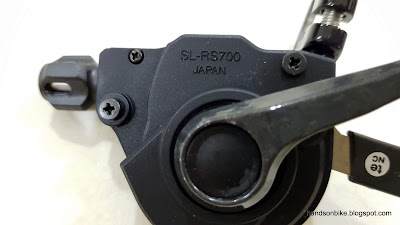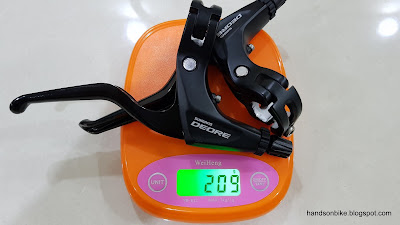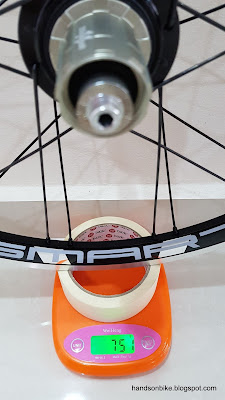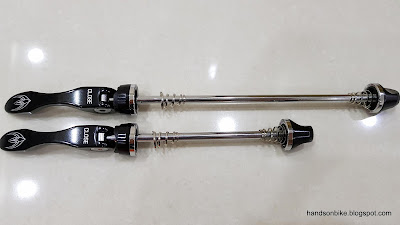As for 11 speed flat handlebar shifters for road, there is not much of a choice, unlike the previous 10 speed generation. For 10 speed road flat handlebar shifters, you could choose between the Tiagra SL-4600 or Ultegra-grade SL-R780 2x10 speed shifters. For 11 speed, the only choice is the non-series SL-RS700 2x10 speed road shifters.
These shifters work and feel exactly like the XTR SL-M9000 shifters, as they share the same construction. The changes are mainly internal, with different cable pitch as road and MTB cable pitch are not compatible.
Pair of non-series 2x11 speed flat handlebar shifters for road, SL-RS700
Slim clamp band, with 11 speed printed on the cover. I chose the black version of the clamp band (silver also available) to match the all black look of the bike.
Rather low profile, with a carbon main lever and a textured surface for more grip and tactile feeling.
Bottom view of the shifter
Although this will be a 1x11 speed setup, I cannot buy just the right side, I have to buy it as a pair. Therefore, the left side shifter will be unused.
Weight of right side SL-RS700 is just 105 grams, which is quite lightweight.
To complement the all black look of the bike, of course I have to choose black coloured brake levers. For V brake levers, there is not much of a choice nowadays, as hydraulic brakes are getting more common. In fact, V brake levers and calipers are now categorized under Trekking instead of MTB.
For all black brake levers, I had a choice of Deore or LX brake levers. On the Dahon MuEX, I did use LX brake levers, so this time I wanted to put on Deore brake levers to see if there will be any difference. Another reason was that LX brake levers were out of stock.
Pair of Deore V brake levers, in all black.
Clean and simple appearance, which appeals to me.
It has an open clamp band design might be useful, if you want to change brake levers without removing the grips. Also I-Spec compatible, but this is an old I-Spec design.
Weight of pair of Deore V brake levers is 209 grams.
So is there any difference between Deore and LX brake levers? The answer is, very minimal. Other than being just 3 grams heavier, the Deore brake levers are also cheap at just $30 for a nice pair. The main difference for me is the surface finishing, where Deore is matte black while LX is gloss black. Either one will be a good choice.
Finally, moving on to the V brake calipers, I chose the LX brake calipers because, well, the Deore one was out of stock. My choices were quite simple, just choose the one that is in stock. Since they are all black in colour, the different brake lever and brake caliper will match anyway.
Pair of front and rear LX V brake calipers.
If you ever bought a pair of V brakes that come in a box, you may have noticed that there is a choice of Front or Rear. Actually, the parts are the same, the difference is how the brake pads are installed at the factory.
Front V brakes are installed facing the front, while rear V brakes are installed facing the rear. Therefore, the brake pads need to be installed in the correct direction to prevent the brake pads from flying out of the brake pad holders.
If you bought the "wrong" side, just swap the left and right brake pads and it will work fine, since the parts are all the same, just assembled differently for the customer's convenience of installation.
Each pair of brake calipers come with 2 mounting bolts, a curved brake noodle, and a rubber boot to keep out the dirt. The curvature of the brake noodle is the same for front or rear, although Avid does it differently.
Closer look at the brake calipers. Make sure you install the brake pads in the correct orientation!
Cable fixing bolt with a washer underneath to prevent the inner cable from fraying when you tighten the bolt. Hopefully these are rust resistant.
One pair of the brake calipers plus hardware is 184 grams. Multiply that by two to get 368 grams for one bike's worth of brake calipers.
With this, most of the components for this new folding bike is ready!























































